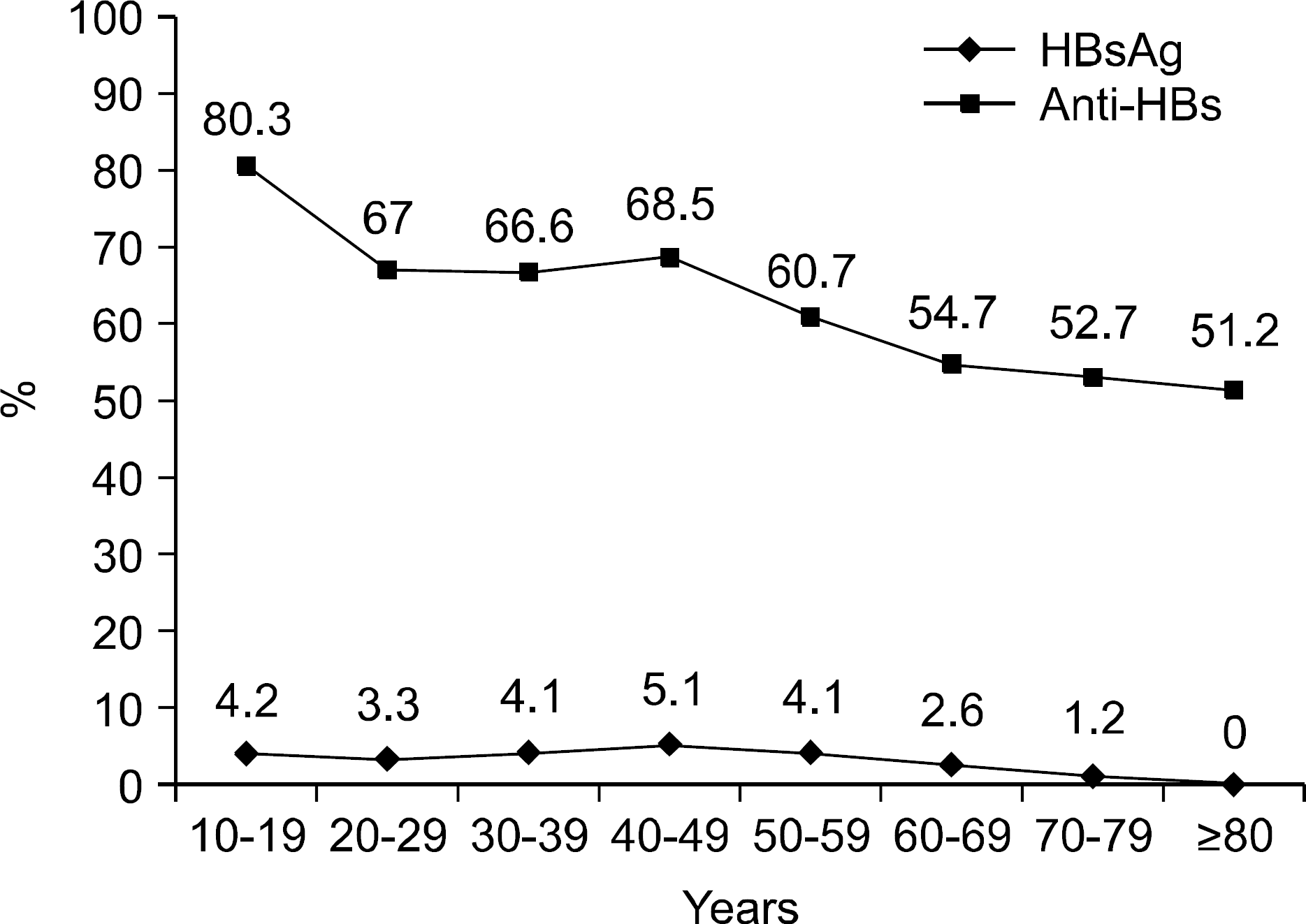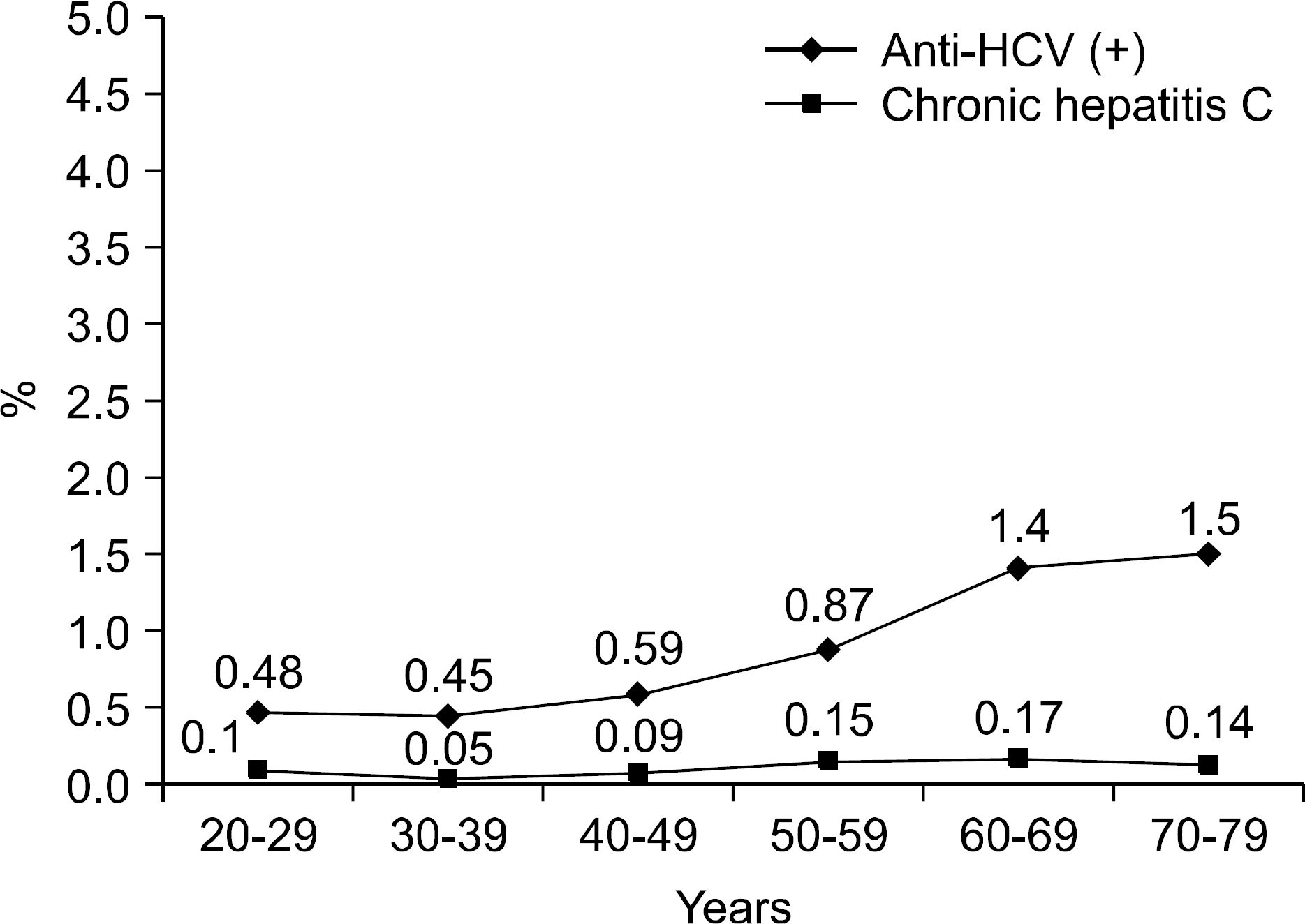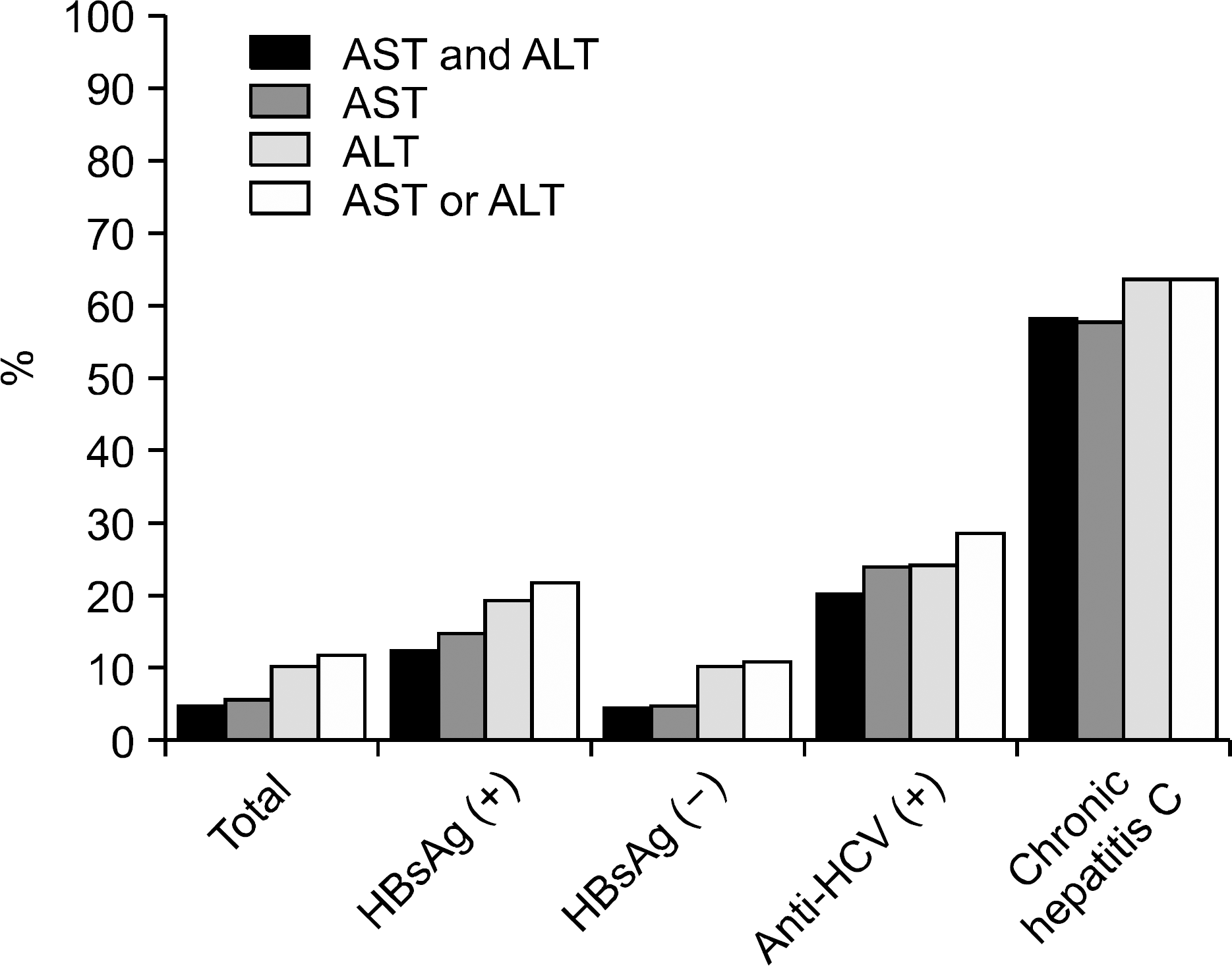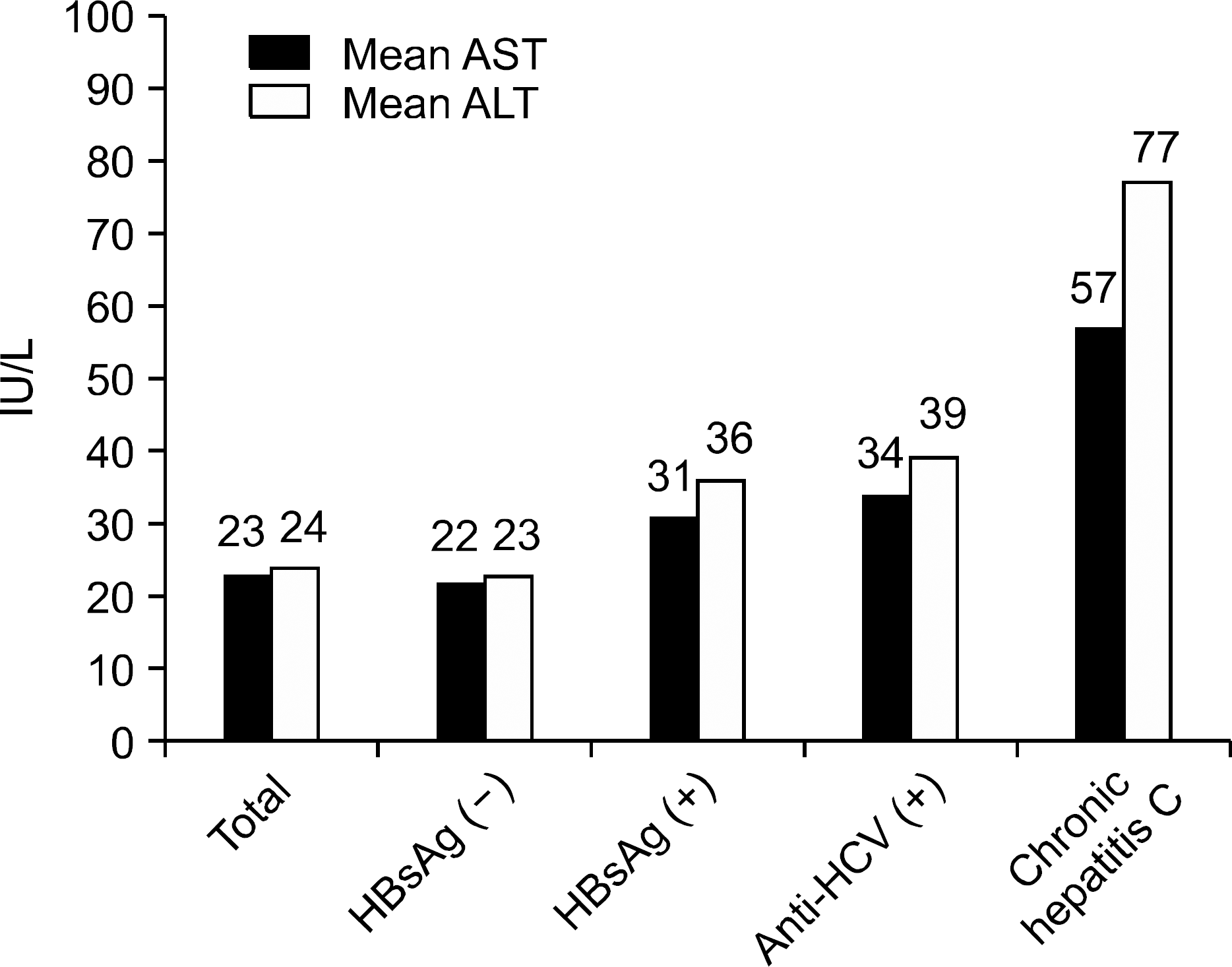Abstract
Background/Aims
We studied the prevalence of chronic hepatitis B, C and abnormality on liver function among the population in northwest area of Chungnam.
Methods
We have reviewed 40,112 adults who had received medical examination at health promotion center in Dankook university hospital. We studied them retrospectively about HBsAg, HBsAb, anti-HCV, and liver function test (LFT).
Results
Among the study subjects, 22,936 men and 17,176 women were involved. The overall seroprevalence of HBsAg was 4.2%. The prevalence in men (4.5%) was higher than that of women (3.7%) (p<0.001). The seroprevalence of HBsAg in their age was 5.1% in the 5th decade, 4.2% in the 2nd decade, 4.1% in the 4th decade, and 4.1% in the 6th decade. The overall seroprevalence of HBsAb was 65.1%. The overall seroprevalence of anti-HCV was 0.7%. After we reexamined them with HCV RNA or RIBA (Recombinant Immunoblot Assay), the prevalence of chronic hepatitis C was 0.09%. The LFT abnormality in total subjects was 11.4%. The LFT abnormality of chronic hepatitis B and C subjects was 21.72% and 63.2%.
Go to : 
REFERENCES
1. Korea National Statistical Office. Annual report on the cause of death statistics. 2006.
2. Shin HR, Kim JY, Jung KY, et al. Prevalence of hepatitis B and C virus infection among adults in Korea. Hepatol Res. 1997; 7:213–225.

3. Lee DH, Kim JH, Nam JJ, Kim HR, Shin HR. Epidemio-logical findings of hepatitis B infection based on 1998 national health and nutrition survey in Korea. J Korean Med Sci. 2002; 17:457–462.

4. Kim CY. Prevention of viral hepatitis, type B, by vaccination with purified hepatitis B surface antigen. J Korean Med Assoc. 1979; 22:1013–1025.
5. Chung KW. Decrease of hepatitis B virus carrier rate in Korea. Korean J Med. 2000; 58:605–607.
6. Kim RK, Ahn BM, Lee DS, et al. Changes in the positivities of HBsAg and anti-HCV antibody among army draftees in Korea. Korean J Hepatol. 2000; 6:474–480.
7. Lee SH, Jung BC, Kim DS, Kim SI. Prevalence of HBsAg and anti-HCV among Korean blood donors. Korean J Blood Transfus. 1994; 5:143–150.
8. Joo KR, Bang SJ, Song BC, et al. Hepatitis B viral markers of Korean adults in the late 1990s: survey data of 70,347 health screenees. Korean J Gastroenterol. 1999; 33:642–652.
9. Park KS, Lee YS, Lee SK, et al. A study on markers of viral hepatitis in adults living in Daegu and Gyungbuk area. Korean J Gastroenterol. 2003; 41:473–479.
10. Zakim D, Boyer TD. Hepatology. 4th ed.Philadelphia: Saunders;2002.
11. Kwon SY, Park IB, Park SH, et al. Significance of anti-HCV in Korea adults. Korean J Med. 1995; 48:361–368.
12. Han SW, Park YU, Kim SM, et al. A study of positive rate of anti-HCV in Korean adults. Korean J Med. 1994; 47:361–368.
13. Jung JI, Sohn SH, Cho WH, Jung JH, Kim YL, Lee JK. Prevalence of anti-HCV in healthy subjects in Ulsan area. Korean J Med. 1993; 45:322–327.
14. Cho NS, Ahn HS. Prevalence of viral hepatitis markers and effectiveness of ALT as a surrogate marker in volunteer donors. Korean J Blood Transfus. 1997; 8:19–29.
15. Shin HK, Yoon JD, Yoo JC, Kim MB, Kim KS, Suh SD. Prevalence of hepatitis C virus antibody in Korea. J Korean Soc Virol. 1993; 23:203–214.
16. Shin HR, Hwang SY, Nam CM. The prevalence of hepatitis C virus infection in Korea: pooled analysis. J Korean Med Sci. 2005; 20:985–988.

17. Kim KM, Kim YJ, Lee KH, Paik DM. Clinical characteristics of factory workers with asymptomatic liver function test abnormalities found on serial health examination. Korean J Hepatol. 2005; 11:144–156.
18. Alter MJ, Mast EE. The epidemiology of viral hepatitis in the United States. Gastroenterol Clin North Am. 1994; 23:437–455.

19. Alter MJ. The detection, transmission, and outcome of hepatitis C virus infection. Infect Agents Dis. 1993; 2:155–166.
Go to : 
 | Fig. 1.Positivities of HBsAg and anti-HBs according to age. The positivity of HBsAg was still high in young age groups. |
 | Fig. 2.Positivities of anti-HCV and chronic hepatitis C according to age. The positivity of anti-HCV increased with age. |
 | Fig. 3.The prevalence of abnormal LFT according to HBsAg(+) and anti-HCV(+) status. The prevalence of abnormal LFT in HBs(+) and anti-HCV(+) subjects HBsAg(−) and anti-HCV(−) subjects with statistical significance (p<0.001). |
 | Fig. 4.The mean AST and ALT levels according to HBs(+) and anti-HCV(+) status. Mean AST and ALT levels of HBs(+) and anti-HCV(+) subjects were higher than those of HBsAg(−) and anti-HCV(−) subjects with statistical significance (p<0.001). |
Table 1.
Age and Gender Characteristics of Study Population
Table 2.
Overall Results of Hepatitis B and C Viral Markers
Table 3.
Prevalence of Abnormal AST and ALT according to Viral Markers




 PDF
PDF ePub
ePub Citation
Citation Print
Print


 XML Download
XML Download